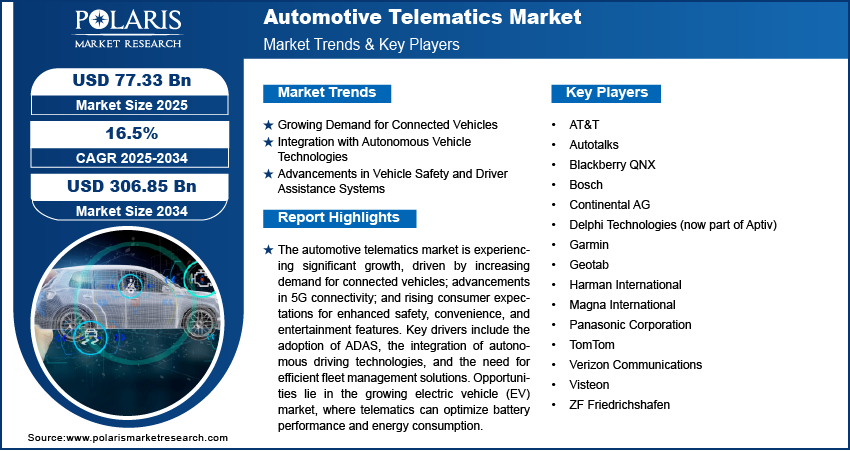Market Overview
The global automotive telematics market size was valued at USD 66.49 billion in 2024 and is projected to grow to USD 77.33 billion in 2025, reaching USD 306.85 billion by 2034. This growth reflects a robust compound annual growth rate (CAGR) of 16.5% over the forecast period from 2025 to 2034. The expansion is largely attributed to rising demand for connected car services, increasing vehicle safety concerns, and government mandates supporting telematics technologies.
Automotive telematics encompasses a wide range of applications, including vehicle tracking, fleet management, crash notification, and remote diagnostics. These systems leverage GPS, onboard diagnostics, and mobile communication to enhance vehicle and driver performance, improve safety, and optimize transportation logistics. As the automotive industry transitions toward autonomous driving and smart mobility, telematics systems are becoming indispensable.
Market Segmentation
Automotive Telematics Market, Channel Type Outlook (Revenue – USD Billion, 2020-2034)
- OEM
- Aftermarket
Automotive Telematics Market, Service Outlook (Revenue – USD Billion, 2020-2034)
- Infotainment & Navigation
- Fleet Management
- Safety & Security
- Diagnostics
Automotive Telematics Market, Technology Type Outlook (Revenue – USD Billion, 2020-2034)
- Embedded
- Tethered
- Integrated
Automotive Telematics Market, Vehicle Type Outlook (Revenue – USD Billion, 2020-2034)
- Passenger Cars
- Commercial Vehicles
Regional Analysis
North America
North America currently leads the global automotive telematics market, with the United States being the largest contributor. High consumer awareness, supportive regulations, and a strong presence of leading technology firms such as Verizon Communications, AT&T, and Geotab drive the regional market. Insurance telematics adoption is also significant in the U.S., where pay-as-you-drive models are gaining popularity.
Europe
Europe is another key region, characterized by stringent EU vehicle safety regulations and emissions mandates. The EU’s eCall initiative, which requires embedded telematics in all new vehicles, has significantly boosted adoption. Major players like Bosch, Continental AG, and ZF Friedrichshafen are headquartered in the region and play pivotal roles in innovation and deployment.
Asia-Pacific
Asia-Pacific is witnessing the fastest growth in telematics adoption, led by countries like China, Japan, South Korea, and India. Rapid urbanization, increased vehicle production, and rising demand for in-car connectivity are key factors. China, in particular, is advancing rapidly with connected vehicle policies and is home to a growing number of domestic telematics solution providers.
Latin America
Latin America shows growing interest in automotive telematics, primarily for fleet management and stolen vehicle tracking. Brazil and Mexico are notable contributors to regional demand. Economic recovery and investments in smart infrastructure are expected to further stimulate market development.
Middle East & Africa
Although still nascent, the Middle East and Africa are gradually adopting telematics for both passenger and commercial applications. Governmental focus on smart transportation and road safety is paving the way for broader implementation.
𝐄𝐱𝐩𝐥𝐨𝐫𝐞 𝐓𝐡𝐞 𝐂𝐨𝐦𝐩𝐥𝐞𝐭𝐞 𝐂𝐨𝐦𝐩𝐫𝐞𝐡𝐞𝐧𝐬𝐢𝐯𝐞 𝐑𝐞𝐩𝐨𝐫𝐭 𝐇𝐞𝐫𝐞:
https://www.polarismarketresearch.com/industry-analysis/automotive-telematics-market
Key Companies Profiled
- AT&T
- Autotalks
- Blackberry QNX
- Bosch
- Continental AG
- Delphi Technologies (now part of Aptiv)
- Garmin
- Geotab
- Harman International (a subsidiary of Samsung Electronics)
- Magna International
- Panasonic Corporation
- TomTom
- Verizon Communications
- Visteon
- ZF Friedrichshafen
These companies are continuously innovating to expand their product portfolios and meet evolving market demands. For instance, Harman International and Blackberry QNX are developing cybersecurity-focused telematics solutions, while Garmin and TomTom are enhancing navigation services with real-time traffic data and over-the-air updates.
Market Drivers
- Growing Demand for Connected Cars
Consumers are increasingly demanding in-vehicle connectivity, including real-time traffic updates, emergency services, entertainment, and remote diagnostics. Automakers are responding by integrating telematics as a standard offering in newer models. - Government Regulations and Safety Mandates
Legislation like Europe’s eCall and similar mandates in other regions require telematics systems in vehicles to ensure faster emergency response times and improved road safety, propelling market adoption. - Fleet Management and Logistics Optimization
Businesses are leveraging telematics to monitor vehicle location, driver behavior, fuel consumption, and route optimization. These systems help reduce operational costs and improve delivery efficiency. - Rise of Usage-Based Insurance (UBI)
Insurers are increasingly adopting telematics to offer personalized insurance plans based on actual driving behavior, encouraging safer driving and reducing claims.
Challenges
- Data Privacy and Security Concerns: Telematics systems collect vast amounts of sensitive data, raising concerns about user privacy and the potential for cyberattacks.
- High Installation Costs: Despite long-term benefits, the initial costs of telematics hardware and software can deter adoption, particularly in emerging markets.
- Connectivity Infrastructure: Inconsistent network coverage in rural and developing areas limits real-time telematics functionality.
- Standardization Issues: Lack of global standards for telematics technology and data integration creates interoperability challenges for OEMs and service providers.
Opportunities
- Expansion of 5G Networks
The rollout of 5G will enhance real-time telematics applications such as autonomous driving, V2X communication, and advanced driver-assistance systems (ADAS). - Integration with Artificial Intelligence (AI)
AI-enabled telematics systems can predict maintenance needs, improve route optimization, and assess driver behavior more accurately, unlocking new value streams for users and fleet managers. - Electric and Autonomous Vehicles
As the automotive industry moves toward electrification and autonomy, telematics will play a central role in managing battery life, charging stations, vehicle diagnostics, and autonomous navigation. - Aftermarket Growth
There’s a rising demand for aftermarket telematics devices that can be retrofitted to existing vehicles, particularly in commercial fleets that want to modernize operations without purchasing new vehicles.
Conclusion
The automotive telematics market is on a fast-paced growth trajectory, driven by technological innovation, regulatory support, and the shifting preferences of consumers and businesses alike. From improving road safety and fuel efficiency to enabling autonomous mobility and smart city integration, telematics is redefining the future of transportation.
With advancements in 5G, AI, and cybersecurity, and increasing demand for connected vehicles, key players like AT&T, Bosch, Garmin, Blackberry QNX, and ZF Friedrichshafen are well-positioned to capitalize on emerging opportunities.
More Trending Latest Reports By Polaris Market Research:
Personal Protective Equipment (PPE) Market
Sex Reassignment Surgery Market
Automotive Blind Spot Detection System Market
Animal Feed Organic Trace Minerals Market

